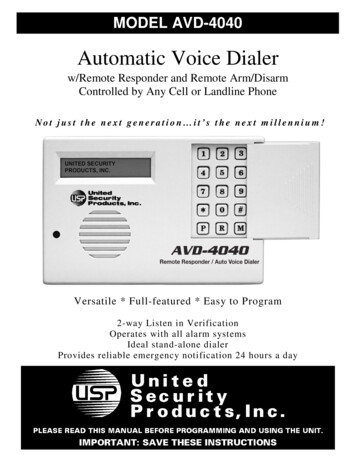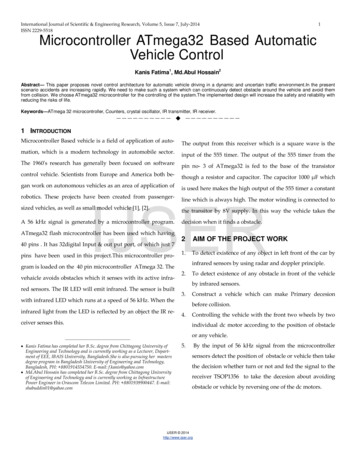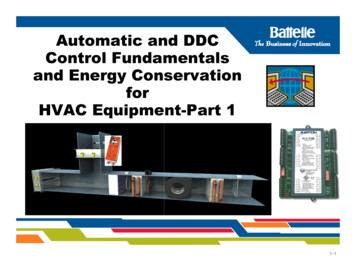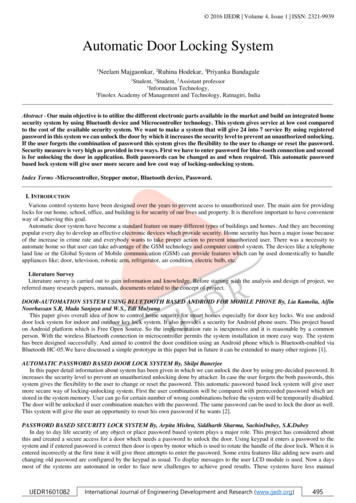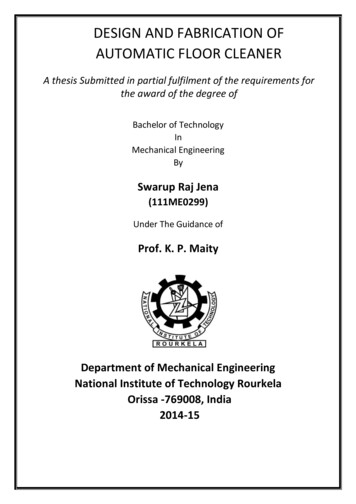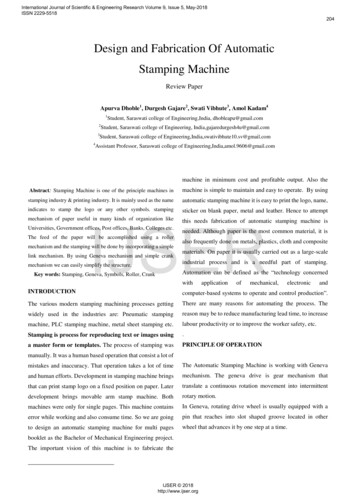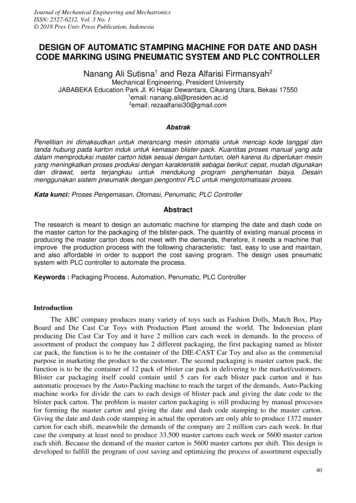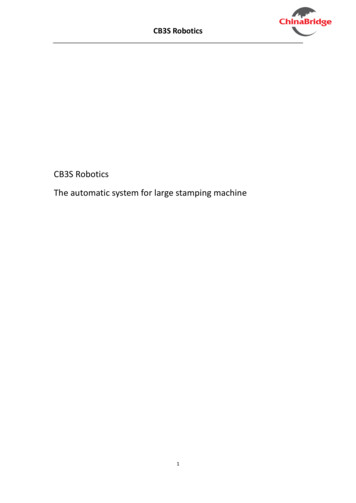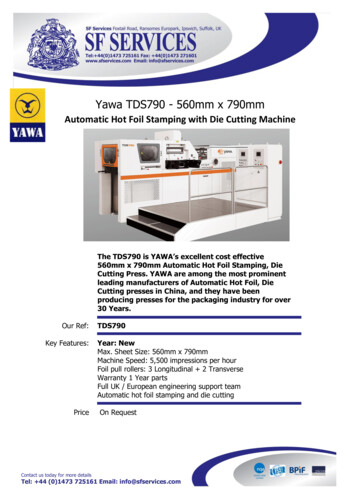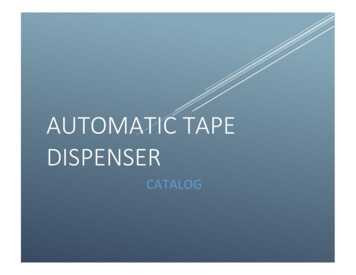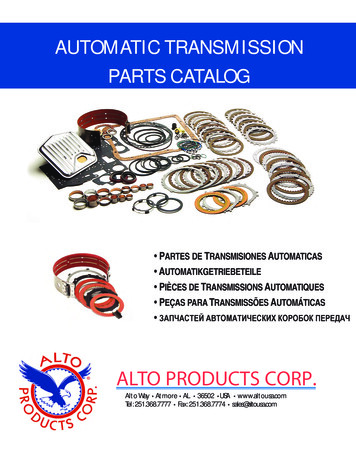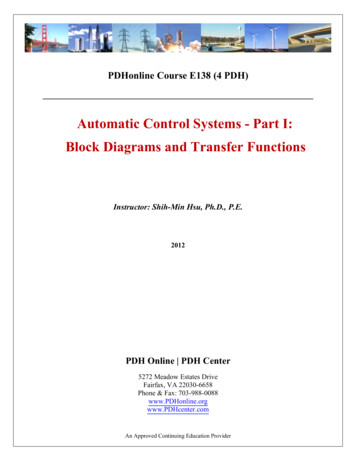
Transcription
PDHonline Course E138 (4 PDH)Automatic Control Systems - Part I:Block Diagrams and Transfer FunctionsInstructor: Shih-Min Hsu, Ph.D., P.E.2012PDH Online PDH Center5272 Meadow Estates DriveFairfax, VA 22030-6658Phone & Fax: 703-988-0088www.PDHonline.orgwww.PDHcenter.comAn Approved Continuing Education Provider
www.PDHcenter.comPDH Course E138www.PDHonline.orgAutomatic Control SystemsPart I:Block Diagrams and Transfer FunctionsBy Shih-Min Hsu, Ph.D., P.E.Page 1 of 21
www.PDHcenter.comI.PDH Course E138www.PDHonline.orgIntroduction:In recent years, control systems have gained an increasingly importance in the developmentand advancement of the modern civilization and technology. Figure 1-1 shows the basiccomponents of a control system. Disregard the complexity of the system, it consists of an input(objective), the control system and its output (result). Practically our day-to-day activities areaffected by some type of control systems. There are two main branches of control systems: 1)Open-loop systems and 2) Closed-loop Fig. 1-1. Basic components of a control system.Open-loop systems:The open-loop system is also called the non-feedback system. This is the simpler of the twosystems. A simple example is illustrated by the speed control of an automobile as shown inFigure 1-2. In this open-loop system, there is no way to ensure the actual speed is close to thedesired speed automatically. The actual speed might be way off the desired speed because of thewind speed and/or road conditions, such as up hill or down hill etc.DesiredspeedControllerEngineActualspeedFig. 1-2. Basic open-loop system.Closed-loop systems:The closed-loop system is also called the feedback system. A simple closed-system is shownin Figure 1-3. It has a mechanism to ensure the actual speed is close to the desired speedautomatically.Desiredspeed ControllerEngineSpeedsensorFig. 1-3. Basic closed-loop system.Page 2 of 21Actualspeed
www.PDHcenter.comPDH Course E138www.PDHonline.orgBlock Diagrams:Because of their simplicity and versatility, block diagrams are often used by control engineers todescribe all types of systems. A block diagram can be used simply to represent the compositionand interconnection of a system. Also, it can be used, together with transfer functions, torepresent the cause-and-effect relationships throughout the system. Transfer Function is definedas the relationship between an input signal and an output signal to a device.Three most basic simplifying rules are described in detail as follows.Series Connection –R(s)G1(s)C(s)G2(s)C(s ) G 1 (s )G 2 (s )R (s ) R(s)G1(s)G2(s)C(s)C(s ) G 1 (s )G 2 (s )R (s )Parallel Connection –R(s)G1(s) G2(s) C(s ) [G 1 (s ) G 2 (s )]R (s ) R(s)G1(s) G2(s)C(s ) G 1 (s ) G 2 (s )R (s )Page 3 of 21C(s)C(s)
www.PDHcenter.comPDH Course E138www.PDHonline.orgFeedback Control Systems –E(s)R(s) C(s)G(s)H(s)C(s ) G (s )E(s )E(s ) R (s ) H(s )C(s )(Error)C(s ) G (s )[R (s ) H(s )C(s )]C(s ) G (s )R (s )1 G (s )H(s ) R(s)G (s )1 G(s)H(s)C(s)C(s )G (s ) R (s ) 1 G (s )H(s )Some basic rules of simplifying block diagrams are tabulated in Table 1-1.Page 4 of 21(1-1)
www.PDHcenter.comPDH Course E138www.PDHonline.orgTable 1-1. Rules of simplifying block diagrams.Case12Original StructureR(s)G1(s)G1(s) G2(s) R(s) R(s)C(s)G2(s)R(s)3Equivalent StructureR(s)C(s)C(s)G1(s)C(s)G1(s)G2(s)C(s)G1(s) G2(s)R(s)C(s)G 1 (s )1 m G 1 (s)G 2 (s) G2(s)ZW4XX5YZXXZGGZ1GXYYZGGGG7GGG81GPage 5 of 21ZGYYX6YW
www.PDHcenter.comPDH Course E138www.PDHonline.orgExample 1-1: Find the transfer function of the closed-loop system below.R(s) 4s 1-C(s)1sSolution:Use case 1 to combine the two series blocksR(s) C(s)4s(s 1)-Use case 3 to obtain the transfer function as follows4C(s )4s(s 1) 2 4R (s )1 1 s s 4s(s 1) Example 1-2: Find the transfer function of the closed-loop system below.R(s) -G1(s) G2(s)-C(s)H(s)Solution:Use case 3 to simplify the inner feedback loop to obtain the following block diagram.R(s) -G1(s)G 2 (s )1 G 2 (s )H(s )Page 6 of 21C(s)
www.PDHcenter.comPDH Course E138www.PDHonline.orgUse case 1 to combine the two series blocks into one.G1 (s )G 2 (s )1 G 2 (s )H(s )R(s) -C(s)Use case 3 to obtain the transfer function for the standard feedback system.G 1 (s )G 2 (s )1 G 2 (s )H(s )G 1 (s )G 2 (s )C(s ) G (s )G 2 (s )1 G 2 (s )H(s ) G 1 (s )G 2 (s )R (s )1 11 G 2 (s )H(s ) Example 1-3: Find the transfer function of the closed-loop system below.G5 G1 G2G3G4Solution:Use case 3 to simplify the inner feedback blocks. G21 G 2G 5G1G4Page 7 of 21G3
www.PDHcenter.comPDH Course E138www.PDHonline.orgUse case 8 to get the following block diagram. RG21 G 2G 5G1G3C1G3G4Use case 1 to combine the two sets of series blocks. G1G 2G 31 G 2G 5G4G3Use 3 to calculate the overall transfer function of the systemG 1G 2 G 31 G 2G 5G 1G 2 G 3C GG G G1 G 2 G 5 G 1G 2 G 4R1 1 2 3 41 G 2G 5 G 3 Systems with Two Inputs:Figure 1-4 shows the block diagram of a system with two inputs, 1) the setpoint, R(s) and2) the load disturbance, D(s). By superposition,D(s)R(s) -G1(s) G2(s)H(s)Fig. 1-4. System with two inputs.Page 8 of 21C(s)
www.PDHcenter.comPDH Course E138www.PDHonline.org(i) The component C ' (s ) produced by R(s) exists only (D(s) 0)C ' (s ) G 1 (s )G 2 (s )R (s )1 G 1 (s )G 2 (s )H(s )(1-2)(ii) Similarly, the component C " (s ) produced by D(s) exists only (R(s) 0)C " (s ) G 2 (s )D(s )1 G 1 (s )G 2 (s )H(s )(1-3)The total value of C(s)C(s) C ' (s ) C" (s ) G 1 (s )G 2 (s )G 2 (s )R (s ) D(s )1 G 1 (s )G 2 (s )H(s )1 G 1 (s )G 2 (s )H(s )(1-4)G 1 (s )G 2 (s )H(s ) is the open-loop transfer function. The characteristic equation is1 G 1 (s )G 2 (s )H(s ) 0(1-5)Page 9 of 21
www.PDHcenter.comII.PDH Course E138www.PDHonline.orgMason Rule:C(s)G(s) R(s) G (s) ii i,(2-1)whereGi(s) path gain of the ith forward path, 1- all individual loop gains gain products of all possible two loops which do nottouch gain products of all possible three loops that do not touch ·····, i the ith forward path determinant the value of for that part of the block diagram thatdoes not touch the ith forward path.A forward path is a path from the input to the output such that no node is included more thanonce. Any closed path that returns to its starting node is a loop, and a path that leads from agiven variable back to the same variable is defined as a loop path. A path is a continuoussequence of nodes, with direction specified by the arrows, with no node repeating.Example 2-1: A block diagram of control canonical form is shown below. Find the transferfunction of the system.b1 b2RΣ Σ 1/s 1/s1/sb3 -a1-a2-a3Solution:Forward path123Path gainG 1 1 (b1 )s11 (b )G2 s s 2G 3 1 1 1 (b3 )s s s( )( )( )( )( )( )Page 10 of 21C
www.PDHcenter.comPDH Course E138www.PDHonline.orgLoop pathl1 1 ( a1 )s11 ( a 2 )l2 s sl3 1 1 1 ( a3 )s s s( )( )( )( )( )( )The determinants area a a 1 (l1 l 2 l 3 ) 1 1 22 33 ;s s s 1 1 (0) ; 2 1 (0) ; 3 1 (0) .Applying Mason’s rule, the transfer function is b1 1 b2 1 b3 1 b1s 2 b2 s b3C(s ) G 1 1 G 2 2 G 3 3 s s2 s3 3aaaR (s ) s a1s 2 a 2 s a31 1 2 2 3 3sss Example 2-2: Find the transfer function of the following system.H1 RH2 ΣH3H4 H5Solution:Forward path12Path gainG 1 H1G 2 H 2 H3H 4Loop pathl1 H 3 H 5Page 11 of 21 ΣC
www.PDHcenter.comPDH Course E138www.PDHonline.orgThe determinants are 1 (l1 ) 1 (H 3 H 5 ) ; 1 1 (l1 ) 1 (H 3 H 5 ) ; (note the forward path 1 does not touch loop path 1) 2 1 (0) ;Applying Mason’s rule, the transfer function isC(s ) G 1 1 G 2 2 H 1 (1 H 3 H 5 ) H 2 H 3 H 4 R (s )1 H 3H5 Example 2-3: Find the transfer function of the following system.H4H6R ΣH1 ΣH2 ΣH3 CΣ H5H7Solution:Forward path12Path gainG1 H 4G 2 H1H 2 H 3Loop pathl1 H 1 H 5 ; (does not touch l3 )l2 H 2 H 6l3 H 3 H 7 ; (does not touch l1 )l4 H 4 H 7 H 6 H 5The determinants are 1 (l1 l 2 l 3 l 4 ) (l1 l3 ) 1 (H 1 H 5 H 2 H 6 H 3 H 7 H 4 H 7 H 6 H 5 ) (H 1 H 5 H 3 H 7 ) ; 1 1 (l 2 ) 1 (H 2 H 6 ) ; (note the forward path 1 does not touch loop path 2) 2 1 (0) ;Page 12 of 21
www.PDHcenter.comPDH Course E138www.PDHonline.orgApplying Mason’s rule, the transfer function isH 4 (1 H 2 H 6 ) H 1 H 2 H 3 1C(s ) G 1 1 G 2 2 R (s )1 (H 1 H 5 H 2 H 6 H 3 H 7 H 4 H 7 H 6 H 5 ) (H 1 H 5 H 3 H 7 ) Example 2-4: The block diagram of a closed-loop system is shown below. For simplicity, all theblocks represent ideal amplifiers. Determine the ratioC.R4R 7C 2356Solution:(7 2 3 5) 1C210210 0.6931R 1 [( 6 2 3) ( 4 7 2) ( 1 7 2 3 5)] 1 36 56 210 303 Mason’s rule is useful for solving relatively complicated block diagrams by hand. Ityields the solution to the graph in the sense that it provides an explicit input-output relationshipfor the system represented by the diagram. The advantage as compared to path-by-pathreduction is that it is systematic and algorithmic.Page 13 of 21
www.PDHcenter.comIII.PDH Course E138www.PDHonline.orgRouth Test:A mathematical method for determining the stability of a system from the open-looptransfer function is the Routh-Hurwitz Stability Criterion (Routh Test). A simplified closed-loopsystem is shown in Figure 3-1. Its transfer function is expressed as follows:C(s )G (s )N(s ) ,R (s ) 1 G (s )H(s ) D(s )(3-1)where N(s) denotes the numerator and D(s) denotes the denominator.E(s)R(s) C(s)G(s)H(s)Fig. 3-1. A simplified closed-loop system.Routh Test starts by expanding the denominator of the closed-loop transfer function,D(s). The D(s) 0 is called the characteristic equation. For the characteristic equation (CE):a 0 s n a1s n -1 a 2 s n - 2 a 3 s n -3 a n 1s a n 0 .(3-2)The coefficients are arranged into the first two rows of an array. Additional rows are calculated.Routh Tablesna0a2a4a6 s n -2s n -3a1b1c1a3b2c2a5b3c3a7 s1s0q1r1sn -1b1 a1a 2 a 0 a3;a1a3b1 a1b2;b1 c1 Obtained from the characteristic equationCalculated by the following equationsb2 a1a 4 a 0 a5;a1b3 a1a 6 a 0 a 7;a1 c2 a5 b1 a1b3;b1c3 a 7 b1 a1b4;b1 Page 14 of 21
www.PDHcenter.comPDH Course E138www.PDHonline.orgTo be a stable system, the necessary and sufficient condition for all the roots of thecharacteristic equation to have negative real parts is that all the elements in the first column be ofthe same sign and none zero. Whenever there is a sign change, it indicates the number of polesin the right-half-plane (RHP) of s-Plane. To be a stable system, all the poles need to be in theleft-half-plane (LHP) of s-Plane.Example 3-1: For the closed-loop system, find the characteristic equation and the range for K tohave a stable system.R(s) Ks(2s 1)(0.5s 1)-C(s)Solution:KC(s )KKs(2s 1)(0.5s 1) 3 KR (s )s(2s 1)(0.5s 1) K s 2.5s 2 s K1 1s(2s 1)(0.5s 1)The characteristic equation: s 3 2.5s 2 s K 0Routh Tables32ss1s0112.5 Kb1c1b1 2.5 1 K 12.5(1)c1 K b1 2.5 0 Kb1(2)To be stable, b1 0 and c1 0 ,From (2)K 0From (1)2.5 K 0 , K 2.5Therefore,0 K 2.5For the system to be stable, 0 K 2.5Page 15 of 21
www.PDHcenter.comPDH Course E138www.PDHonline.orgExample 3-2: Find the range of K so that the system shown is stable. where G p (s ) G p (s )K2.s 4s 5s 232Solution:The characteristic Equation can be obtained by1 KG p (s )H(s ) 01 2K 0s 4s 2 5s 23s 3 4s 2 5s (2 2K ) 0s 3 4s 2 5s 2Therefore,CE s 3 4s 2 5s (2 2K ) 0Routh Table:s3s2s1s0b1 14b1c15(2 2K )4 5 1 (2 2K ) 9 K 42(1)b1 (2 2K ) 0 0 2 2K(2)b1To have a stable system, b1 and c1 must be greater than zero.c1 From (2)2 2K 0 K 1From (1)9 K 02 K 9Therefore, the range of K to have the system stable is 1 K 9Page 16 of 21
www.PDHcenter.comPDH Course E138www.PDHonline.orgExample 3-3: The Characteristic Equation of a closed-loop system isCE s 5 15s 4 20s 3 10s 2 5s 100 0Is this system stable?Solution:Routh Tables5s4s3s2s1s0115b1c1d1e120 510 100b2c2b1 15 20 1 10 290 19.333 01515b2 15 5 1 100 25 1.6671515c1 19.333 10 15 ( 1.667 ) 218.335 11.293 019.33319.333c2 19.333 100 15 0 10019.333d1 11.293 ( 1.667 ) 19.333 100 1952.125 172.862 011.29311.293e1 172.862 100 11.293 0 100 0 172.862Since d 1 is negative while the other elements in the first column are positive, the systemis unstable and has two poles on the right-half-plane (RHP). The number of poles on the righthalf-plane is determined by the number of changing sign of the elements in the first column ofthe Routh Table. Figure 3-2 shows the Routh Table with only the elements in the first columnand when the sign changes take place.Page 17 of 21
www.PDHcenter.comPDH Course E138s51 s4s31519.333s2s111.293 172.862 s0100 www.PDHonline.orgSign change from to Sign change from - to Fig. 3-2. 1st column of Routh Table showing sign changes. Special Cases:1.2.The first element in any one row of the Routh Table is zero, but the other elementsare not.The elements in one row of the Routh Table are all zero.In the first case, if a zero appears in the first position of a row, the elements in the next row willall become infinite, and the Routh Test breaks down. In this case, one may replace the zeroelement in the Routh Table by an arbitrary small positive number ε and then proceed with theRouth Test.Example 3-4: The Characteristic Equation of a closed-loop system isCE s 3 3s 2Is this system stable?Solution:Routh Tables31 -32s0 21 sBecause of the zero in the first element of the second row, the first element of the third row isinfinite. In this case one may replace zero with a s
www.PDHcenter.com PDH Course E138 www.PDHonline.org . Block Diagrams: Because of their simplicity and versatility, block diagrams are often used by control engineers to describe all types of systems. A block diagram can be used simply to represent the composition
